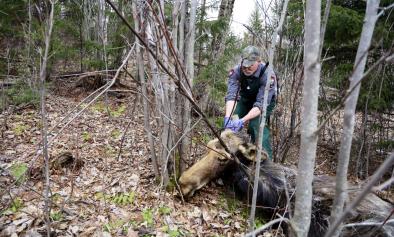Science Source
Climate Change and Considerations for Fish Health and Fish Health Professionals
- Introduces the Venn diagram that fish health professionals classically refer to in order to characterize the factors that contribute to infectious disease:

- The effects of climate change on the terrestrial environment and inland waters are numerous and may include increases in temperatures, changes in precipitation patterns (e.g., changes in rainfall, reduced snowpack), alterations in flow regimes (e.g., lower summertime in-stream flows), more frequent extreme weather events (e.g., droughts and floods), and other abiotic effects that impact the quantity and quality of surface water needed for aquatic life
- Abiotic changes, in turn, cause biotic changes, affecting aquatic organisms whose geographic distributions, life histories, and biological requirements are directly tied to “master variables” like temperature and flow
- Biotic shifts, such as advancing eutrophication or changes in species assemblages, may negatively affect the health of wild and hatcheryorigin fish at an individual or population scale
- Altered environments, defined by new abiotic and biotic norms, may present novel fish–pathogen interactions and the potential for emerging infectious diseases; for example, favorable thermal habitats that provide refuge from pathogens may be lost due to climate change, resulting in increased incidence of disease
- Holds that disease-related morbidity and mortality are influenced by water temperature, whether the result of increased fish susceptibility, greater pathogen virulence, or both
- As long as temperatures do not exceed the pathogen’s thermal preferendum, bacterial and viral infections may progress more rapidly and be more severe when water temperatures are warmer or rising
- The effects of water temperature on parasitic infections are more variable, with warm temperatures associated with more severe infestations of some parasites
- Freshwater temperature increases can affect fish pathogens directly by altering their biological processes or indirectly by influencing the distribution and abundance of the fish they affect
Click here to read this article in the July 2016 Fisheries Magazine special edition titled, "Perspectives on Climate Change."
Related Content
Science Source
| Global Change Biology
Decadal-scale phenology and seasonal climate drivers of migratory baleen whales in a rapidly warming marine ecosystem
Daniel E. Pendleton, Morgan W. Tingley, Laura C. Ganley et al
Headline

May 19, 2022 | Climate Nexus Hot News
Climate Change Great For Winter Ticks, Very Bad For Moose Calves
Science Source
Climate change increases cross-species viral transmission risk
Colin J. Carlson, Gregory F. Albery, Cory Merow et al
Science Source
| Journal of Animal Ecology
Climate change affects bird nesting phenology: Comparing contemporary field and historical museum nesting records
John M. Bates, Mason Fidino, Laurel Nowak-Boyd et al


